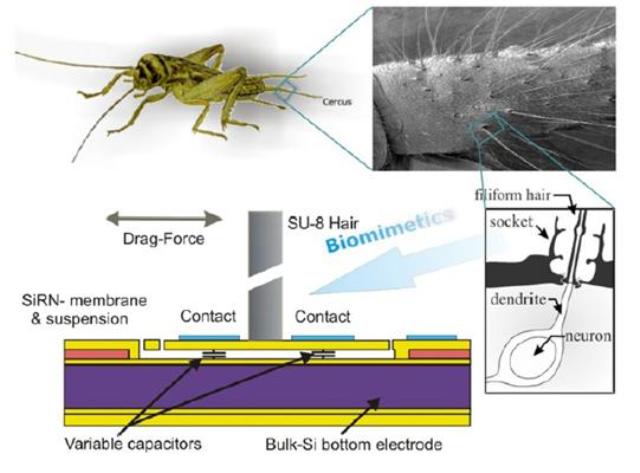Mar 12 2013
Crickets use sensitive hairs on their cerci (projections on the abdomen) to detect predators. For these insects, air currents carry information about the location of nearby predators and the direction in which they are moving.
 Cricket hairs inspire UT researchers
Cricket hairs inspire UT researchers
These University of Twente researchers wondered whether they could use the same principle to create a new kind of “camera”, capable of imaging entire flow patterns rather than measuring flows at a single point. They mimic the cricket hairs using microtechnology. The hairs themselves are made of a type of epoxy, which is attached to a flexible suspended plate. That acts as a capacitor, whose capacitance varies with movement. Measuring that variation gives you information about the movement. Using an entire field or array of such fine hairs, it is possible to identify patterns in the flow, in much the same way as complete images are formed from the individual pixels detected by chips in cameras.
Flow camera
The trick is then to be able to read each hair individually. To this end, a range of options have been explored. Frequency Division Multiplexing (FDM) offers the greatest advantages. With FDM, the measured signal is not delayed while in transit, it is not difficult to synchronize the individual sensors, and the sensor array can easily be expanded without sacrificing performance. Also, the hardware involved is less complex than that required by other technologies. Looking ahead, the researchers believe that it will ultimately be a relatively simple matter to integrate the sensors and the hardware. This will result in a “camera” that is capable of imaging flow patterns. These could be used as a motion detection system in robots, for example.
The study by Ahmad Dagamseh and his colleagues was carried out in the Transducer Science and Technology group, headed by Professor Gijs Krijnen. The group is part of the University of Twente’s MESA+ Institute for Nanotechnology. Their research was funded by the EU’s Customized Intelligent Life-Inspired Arrays programme (CILIA), and by the “Bio-EARS” VICI grant awarded to Gijs Krijnen by the Netherlands Organization for Scientific Research (NWO) and the STW Technology Foundation.